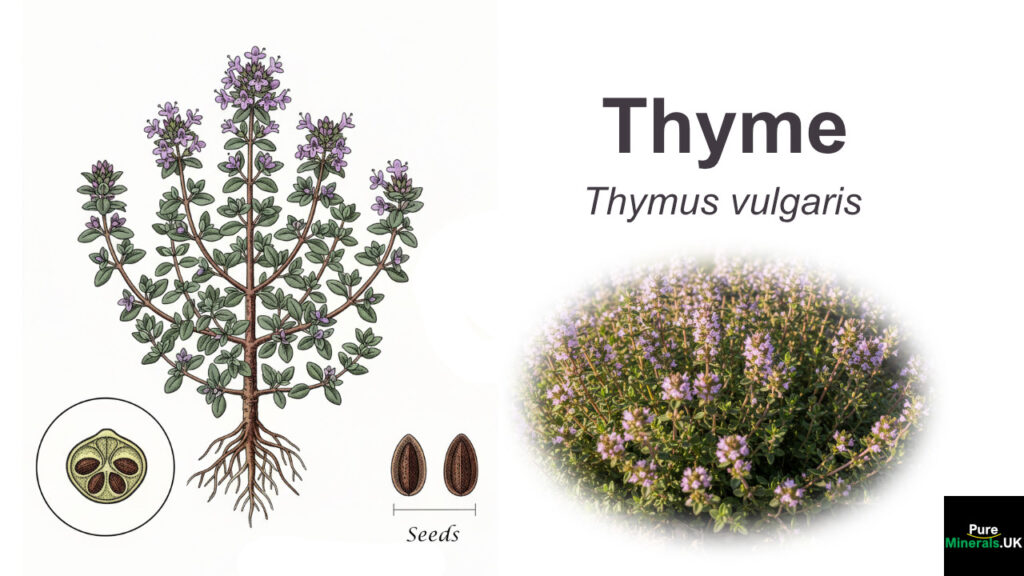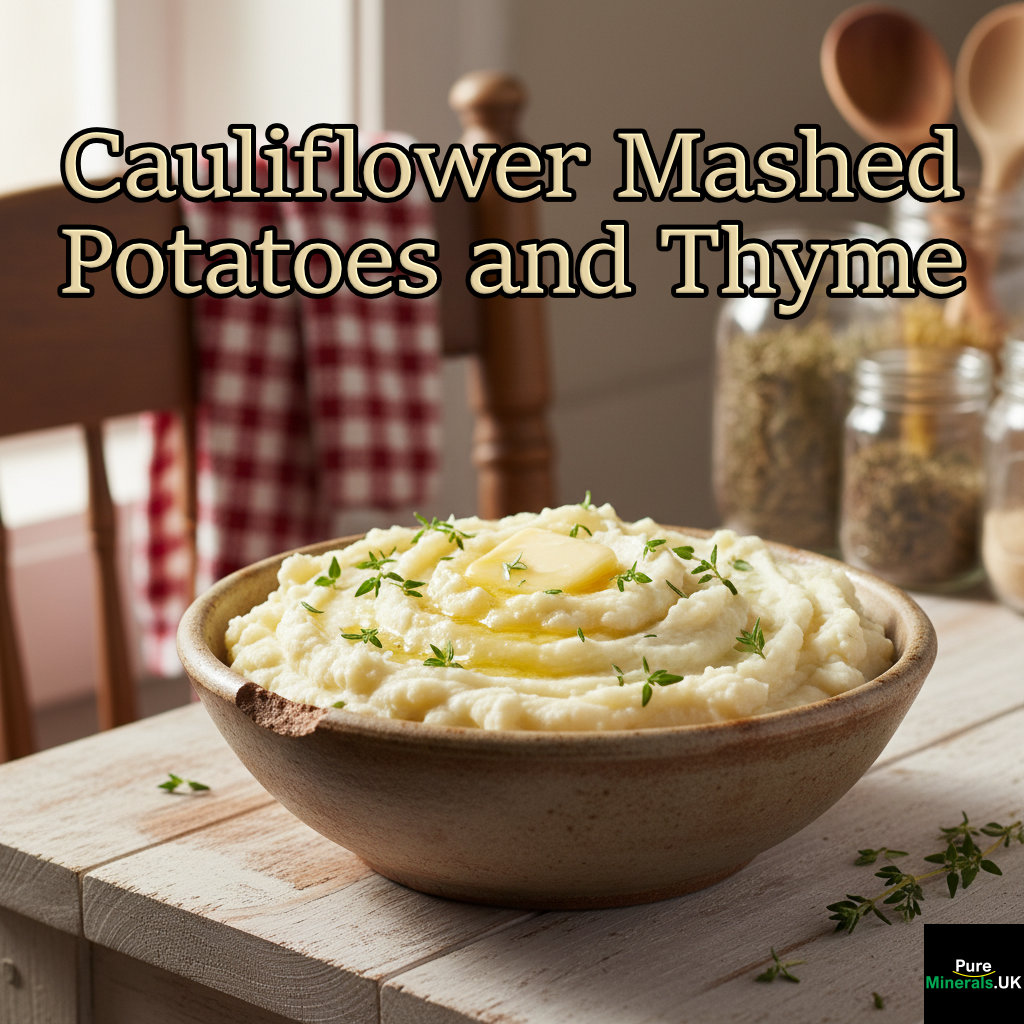
Key Takeaways
- Thymol, the active compound in thyme, exhibits powerful antibacterial and antifungal properties that make it an effective natural antiseptic.
- Scientific studies confirm thyme essential oil can combat resistant bacterial strains and common fungal infections, making it a valuable addition to your natural medicine cabinet.
- Thyme offers multiple health benefits beyond cooking, including respiratory support, acne treatment, and oral health protection.
- Creating homemade thyme-based antiseptic solutions is simple and provides a chemical-free alternative to commercial products.
- While generally safe, proper concentration and application methods are essential when using thyme’s antiseptic properties therapeutically.
Thyme isn’t just that fragrant herb sitting in your spice rack. This Mediterranean staple holds remarkable antiseptic powers that have been utilized for centuries before modern medicine. From ancient Egyptian embalming practices to medieval plague remedies, thyme’s germ-fighting abilities have stood the test of time.
The secret behind thyme’s antiseptic prowess lies in its essential oils, particularly thymol – a compound so effective that it’s used in commercial mouthwashes and disinfectants today. With antibiotic resistance becoming increasingly concerning, Nature’s Wellness is championing thyme as a natural alternative worth exploring for minor infections and preventative care.
In this comprehensive guide, we’ll explore how this humble herb can transform your approach to home remedies while adding distinctive flavor to your favorite dishes. The dual benefits of thyme – both medicinal and culinary – make it one of the most valuable plants in your natural health arsenal.

Thyme’s Powerful Antiseptic Properties Will Transform Your Medicine Cabinet
Thyme vs. Commercial Antiseptics
Studies show that thymol (20-54% of thyme essential oil) demonstrates comparable effectiveness against common bacteria to many over-the-counter antiseptics, but with fewer harsh chemicals and a more pleasant aroma. This makes it particularly valuable for sensitive skin applications and household use where chemical exposure is a concern.
Long before pharmaceutical companies bottled antiseptics, Mediterranean households relied on thyme for everything from preserving food to treating wounds and respiratory ailments. The concentrated essential oils in thyme leaves – particularly thymol – create a hostile environment for bacteria, fungi, and certain viruses. Unlike many commercial products that may contain harsh chemicals, thyme offers a gentler approach with fewer side effects when used appropriately.
The versatility of thyme as an antiseptic solution is perhaps its greatest strength. From gargling with thyme tea for sore throats to applying diluted thyme oil on minor cuts, this herb offers multiple applications for common household health needs. Its effectiveness comes without the chemical smell of traditional antiseptics – instead, you’ll enjoy the herb’s distinctive aromatic profile that has defined Mediterranean cuisine for generations.
What makes thyme particularly relevant today is growing research supporting traditional uses with scientific validation. A 2011 in vitro study found thyme oil effective against resistant bacterial strains, while a more recent 2021 study confirmed its potency against Candida albicans, a common cause of fungal infections. This scientific backing gives confidence that incorporating thyme into your natural medicine cabinet isn’t just folklore but evidence-based practice.
The Science Behind Thymol: Nature’s Potent Germ Fighter

Thyme’s antiseptic superpowers come primarily from thymol, a phenolic compound that dominates its essential oil profile. But how exactly does this natural compound work against harmful microorganisms? The mechanism involves disrupting cell membranes of bacteria and fungi, essentially creating holes in their protective coverings. This disruption leads to cellular content leakage and ultimately microbial death – all without harming human cells when used in appropriate concentrations.
What Makes Thymol a Powerful Antiseptic
Thymol’s molecular structure gives it unique properties that make it exceptionally effective against a broad spectrum of pathogens. The hydroxyl group in thymol allows it to interact with proteins in microbial cell membranes, altering their permeability and function. This interaction is particularly devastating for gram-positive bacteria like Staphylococcus aureus, which causes many skin infections. Additionally, thymol demonstrates synergistic effects when combined with other compounds in thyme, like carvacrol, enhancing its antimicrobial potency beyond what either compound could achieve alone.
How Thymol Attacks Harmful Bacteria and Fungi
Unlike some antiseptics that work through a single mechanism, thymol employs multiple pathways to combat pathogens. It not only damages cell membranes but also disrupts energy metabolism and inhibits essential enzymes microbes need for survival. This multi-pronged approach explains why resistance to thymol is less common than to conventional antibiotics. For fungi like Candida albicans, thymol interferes with biofilm formation – a protective matrix that makes infections more persistent and difficult to treat.
Concentration Levels in Different Thyme Varieties
Not all thyme varieties are created equal when it comes to antiseptic potency. Spanish thyme (Thymus zygis) and common thyme (Thymus vulgaris) contain the highest thymol concentrations, with some specimens showing levels of 40-54% in their essential oils. Lemon thyme (Thymus citriodorus), while fragrant and delicious, contains lower thymol levels but compensates with higher citral content, which has its own antimicrobial properties. Wild thyme (Thymus serpyllum) falls somewhere in the middle, offering a balanced profile that makes it versatile for both culinary and medicinal applications.
The growing conditions significantly impact thymol concentration in all varieties. Thyme plants cultivated in hot, dry environments with poor soil tend to produce higher essential oil concentrations as a stress response. This explains why thyme from Mediterranean hillsides often demonstrates superior antiseptic properties compared to greenhouse-grown counterparts. Harvesting time also matters – thyme collected just before flowering shows peak thymol levels, making this the optimal harvesting window for medicinal purposes.
6 Proven Health Benefits of Thyme’s Antiseptic Properties
1. Respiratory Infection Fighter
Thyme’s affinity for the respiratory system makes it exceptionally valuable during cold and flu season. The volatile oils in thyme, particularly thymol, have expectorant properties that help loosen mucus while simultaneously fighting the bacteria that can cause secondary infections. This dual-action approach explains why thyme has been a cornerstone in traditional cough remedies across Europe for centuries. Modern research supports this use, with studies showing thymol’s effectiveness against common respiratory pathogens like Streptococcus pneumoniae and Haemophilus influenzae.
For respiratory applications, thyme can be used as a steam inhalation, throat gargle, or internal tea. The steam method delivers the antiseptic compounds directly to inflamed mucous membranes, while tea provides systemic benefits. Most impressive is thyme’s ability to combat biofilm formation in the respiratory tract – those stubborn bacterial communities that contribute to chronic infections and antibiotic resistance.
2. Natural Acne Treatment
Acne sufferers have a powerful ally in thyme’s antimicrobial properties. A 2010 study published in the Journal of Medicinal Plants Research found that thyme essential oil showed remarkable activity against Propionibacterium acnes, the bacteria implicated in acne formation. What’s particularly noteworthy is that thyme outperformed benzoyl peroxide in laboratory tests while causing less irritation to surrounding tissues.
The anti-inflammatory compounds in thyme, including rosmarinic acid and luteolin, complement its antibacterial action by reducing redness and swelling associated with acne lesions. When properly diluted in a carrier oil or alcohol-free witch hazel, thyme provides a natural alternative to harsh chemical treatments. Regular application can help regulate sebum production while maintaining the skin’s beneficial microbial balance – something many conventional acne treatments disrupt.
3. Oral Health Protector
The commercial dental industry has long recognized thymol’s value, incorporating it into mouthwashes like Listerine. The compound’s ability to eliminate oral pathogens without harming beneficial flora makes it ideal for maintaining oral health. Studies show that thymol effectively targets Streptococcus mutans and other bacteria responsible for plaque formation and tooth decay.
Beyond cavity prevention, thyme’s astringent properties help tighten gum tissue and reduce inflammation associated with gingivitis. Its pleasant taste and breath-freshening qualities make it more appealing than harsh antiseptic mouthwashes. Traditional Mediterranean cultures have long used thyme-infused mouthwashes and chewed fresh thyme leaves to maintain dental health – practices now validated by dental research demonstrating significant reductions in oral bacteria following thyme rinses.
4. Wound Healing Support
Thyme’s wound-healing capabilities extend beyond simple antisepsis. While thymol prevents infection by eliminating pathogens that might colonize a wound, other compounds in thyme stimulate circulation and cell proliferation at the injury site. This combined action accelerates healing while minimizing scarring. The herb’s traditional use as a wound wash in Mediterranean folk medicine has been substantiated by research showing thyme extract stimulates fibroblast activity – the cells responsible for collagen production in healing tissue.
For minor cuts and scrapes, a thyme infusion provides gentle yet effective cleansing without the stinging associated with alcohol-based antiseptics. The herb’s natural tannins contribute additional benefits by temporarily tightening the skin’s surface, helping to stop minor bleeding and create a protective barrier. These properties make thyme particularly valuable for treating kitchen accidents – ironically often occurring while cooking with the herb! For more on herbs, learn about the benefits of savory, another culinary favorite.
5. Antifungal Properties for Skin Conditions
Thyme demonstrates remarkable potency against common fungal pathogens that plague human skin. Conditions like athlete’s foot, ringworm, and candida overgrowth respond well to thyme’s antifungal compounds, particularly thymol and carvacrol. A 2021 study found that very low concentrations of thyme oil exhibited fungicidal activity against Candida albicans, including strains resistant to conventional antifungal medications. For more insights on herbal remedies, explore the benefits of rosemary.
The effectiveness of thyme against fungal infections stems from its ability to disrupt the fungal cell membrane while simultaneously interfering with ergosterol synthesis – a compound essential for fungal cell wall integrity. This multi-targeted approach makes thyme especially valuable for persistent fungal conditions. When applied consistently, thyme preparations can resolve stubborn infections without the side effects associated with prescription antifungals. The herb’s natural compounds also help restore skin’s pH balance, creating an environment less hospitable to fungal recurrence.
Harvesting and Preserving Methods to Retain Thymol Content
To maximize thyme’s antiseptic potential, timing your harvest is crucial. Collect thyme sprigs in mid-morning after dew has evaporated but before the hot midday sun depletes essential oils. The optimal harvest window is just before flowering when thymol concentrations peak. Using sharp scissors to cut stems about 2 inches from the base minimizes plant stress and encourages robust regrowth for future harvests.
Preservation methods significantly impact thyme’s medicinal potency. Air-drying in small bundles hung upside down in a dark, well-ventilated space preserves up to 80% of thyme’s volatile oils, compared to just 40-50% retention with high-temperature dehydrators. For maximum thymol preservation, consider freezing fresh sprigs or creating alcohol tinctures, which can maintain potency for up to two years. Avoid storing dried thyme in plastic containers, as they can cause condensation that degrades essential oils; instead, use dark glass jars kept away from heat sources. For more on preserving herbs, check out this guide on savory.
Safety Considerations and Precautions
While thyme offers powerful natural antiseptic benefits, responsible usage requires understanding its potency and limitations. Thyme essential oil should never be applied undiluted to skin as its concentrated nature can cause irritation or allergic reactions. For therapeutic purposes, always dilute thyme oil to 1-2% concentration in a carrier oil like jojoba or olive oil. When using thyme internally as tea or tincture, moderation is key – the same compounds that make thyme medicinal can cause digestive upset when consumed in excess.
Potential Side Effects and Allergic Reactions
Though generally recognized as safe, thyme can cause adverse reactions in sensitive individuals. The most common side effects include skin irritation, redness, or burning sensation when applied topically, especially with concentrated forms like essential oils. Some people experience contact dermatitis from handling fresh thyme, particularly those with allergies to other plants in the Lamiaceae family (mint, oregano, sage). Internally, excessive thyme consumption may lead to gastrointestinal discomfort, heartburn, or dizziness. Anyone experiencing these symptoms should discontinue use immediately and consult a healthcare professional if symptoms persist.
Proper Dosage Guidelines
For therapeutic purposes, dosage depends on the preparation method and intended use. For thyme tea, steep 1-2 teaspoons of dried thyme in 8 ounces of hot water for 10-15 minutes, consumed up to three times daily. Thyme tinctures typically require 20-40 drops diluted in water, taken 1-3 times daily. Topical applications should use a 1-2% dilution of essential oil (approximately 6-12 drops per ounce of carrier oil) for general skin applications, or up to 5% for targeted treatments like fungal infections. For thyme-infused oil, a standard ratio is 1 cup of carrier oil to 1/4 cup dried thyme, solar-infused for 2-4 weeks. Always start with lower concentrations to test your sensitivity before increasing strength.
Who Should Avoid Thyme and Thymol Products
Certain populations should exercise caution with thyme-based remedies. Pregnant women should avoid therapeutic concentrations of thyme essential oil, as its emmenagogue properties could potentially stimulate uterine contractions, though culinary amounts are generally considered safe. Individuals with hormone-sensitive conditions like breast cancer or endometriosis should consult healthcare providers before using thyme medicinally due to its mild hormonal effects. Those taking blood-thinning medications should be aware that thyme can enhance anticoagulant activity, potentially increasing bleeding risk. People with hypertension should monitor their response to thyme supplements, as they may lower blood pressure.
Children under 6 years should not use thyme essential oil preparations, while diluted forms may be appropriate for older children under proper supervision. Always consult a qualified healthcare practitioner before using thyme medicinally if you have underlying health conditions or take prescription medications, as interactions are possible despite thyme’s natural origin.
Transform Your Health with This Ancient Mediterranean Remedy
The beauty of thyme lies in its accessibility and versatility – this powerful medicinal herb can be grown on a windowsill, purchased affordably at grocery stores, or wildcrafted in appropriate settings. By incorporating thyme’s antiseptic properties into your wellness routine, you’re connecting with a healing tradition that spans millennia while embracing evidence-based natural care. Whether you’re brewing thyme tea for a sore throat, creating a wound wash for minor cuts, or diffusing thyme oil to purify indoor air, this Mediterranean herb offers protective benefits that complement conventional healthcare approaches.
For those seeking to reduce chemical exposure while maintaining effective antiseptic practices, Nature’s Wellness offers a range of organic thyme products, from therapeutic-grade essential oils to pre-formulated thyme-based skin care solutions. Their commitment to sustainable harvesting and precision extraction methods ensures maximum thymol content for optimal antiseptic benefits while supporting traditional farming communities throughout the Mediterranean region.
5 Great Thyme Dishes
1. Chicken Pot Pie with Leeks and Thyme

Chicken Pot Pie with Leeks and Thyme is a warm, aromatic savoury pie built around tender pieces of chicken and a creamy vegetable filling. The sweetness of gently cooked leeks forms the backbone of the flavour, while fresh thyme threads through the dish with a soft, herbal fragrance. Carrots, celery, and garlic add structure and depth, all bound together in a velvety sauce enriched with stock and milk or cream.
The filling is enclosed beneath a golden sheet of puff pastry that rises as it bakes, forming a crisp, flaky crust that contrasts with the soft, rich interior. When served, the pastry cracks to reveal steam scented with thyme and buttery chicken, giving the dish both comfort and a refined edge. It is hearty but not heavy, rustic yet elegant, and ideal for a satisfying meal on a cool evening.
2. Roast Turkey with Shallot Butter and Thyme Gravy

Roast Turkey with Shallot Butter and Thyme Gravy is a classic centerpiece dish distinguished by its aromatic richness and crisp, bronzed skin. The bird is coated with a shallot-infused butter that melts into the meat as it roasts, keeping the flesh moist while lending a subtle sweetness and a gentle, savoury depth. The butter also helps the skin develop a deep golden colour and a delicate, crisp texture.
As the turkey cooks, its pan juices combine with roasted shallots, thyme, and natural fats to form the foundation of the gravy. Once reduced and finished with stock, it becomes smooth, fragrant, and lightly herbal, complementing the mild flavour of the turkey without overpowering it. The result is a roast that is tender, aromatic, and balanced, with a gravy that ties together every element of the plate—ideal for festive occasions or any meal that calls for a refined, traditional roast.
3. Buttery Sautéed Mushrooms with Fresh Thyme

Buttery Sautéed Mushrooms with Fresh Thyme is a simple yet refined dish that highlights the natural earthiness of mushrooms and the aromatic lift of fresh herbs. The mushrooms are cooked in a generous amount of butter until they release their moisture, deepen in colour, and develop a gentle, caramelized edge. This creates a soft, savoury base with a rich aroma.
Fresh thyme is added near the end of cooking, allowing its delicate herbal notes to infuse the butter without losing their brightness. A touch of seasoning enhances the mushrooms’ natural depth, resulting in a side dish that is warm, fragrant, and full of character. It pairs comfortably with roasts, poultry, steaks, or can stand alone as a simple, flavorful accompaniment.
4. Honey and Thyme Custard with Apple Pie

Honey and Thyme Custard with Apple Pie is a warmly aromatic dessert that blends familiar comfort with a subtle herbal flourish. The custard is smooth and gently sweetened with honey, giving it a floral depth that differs from standard sugar-based versions. Fresh thyme is infused into the cream as it warms, adding a light, fragrant note that complements rather than dominates the sweetness.
Served alongside a classic apple pie—or poured over it while still warm—the custard pools around the slices, enhancing the spiced apples and flaky crust with its velvety texture. The combination delivers a balance of buttery pastry, tender fruit, and a mellow, honeyed cream lifted by a whisper of thyme. It is indulgent without being heavy, familiar yet slightly unexpected, and well suited to an elegant finish after a comforting meal.
5. Cauliflower Mashed Potatoes and Thyme

Cauliflower Mashed Potatoes with Thyme is a light, aromatic alternative to traditional mash, combining the creaminess of potatoes with the gentle sweetness and softness of cooked cauliflower. When blended together, the two vegetables create a smooth, velvety texture that feels rich while remaining noticeably lighter than a full-potato mash.
Butter and a touch of cream provide depth, while fresh thyme adds an herbal brightness that lifts the flavour without overwhelming it. The thyme’s subtle fragrance works particularly well with the delicate nuttiness of cauliflower, giving the dish a clean, refined profile. The result is a comforting, softly textured side that pairs easily with roasted meats, poultry, or vegetable mains, offering both warmth and a fresh, aromatic finish.
Frequently Asked Questions
The following questions address common concerns about utilizing thyme’s antiseptic properties safely and effectively for various applications.
Is thyme essential oil the same as thymol?
No, thyme essential oil and thymol are not identical. Thyme essential oil is a complex mixture containing many compounds, with thymol typically comprising 20-54% of its composition depending on the thyme variety and growing conditions. Thymol is the isolated phenolic compound responsible for much of thyme’s antiseptic activity, which can be extracted and used separately in pure form. Commercial products containing “thymol” often use the isolated compound rather than whole essential oil, allowing for standardized potency and reduced variation. For most home applications, however, whole thyme oil provides a broader spectrum of benefits due to the synergistic effects between thymol and other natural compounds like carvacrol and p-cymene.
Can I use thyme antiseptic solutions on my pets?
Thyme should be used cautiously with pets, particularly cats who lack enzymes to process certain plant compounds. Dogs generally tolerate very dilute thyme preparations (0.1-0.5% essential oil) for minor skin issues, but never apply thyme oil near animals’ faces or in areas they might lick. A safer approach is using hydrosols (floral waters) of thyme, which contain minimal essential oils but retain gentle antiseptic properties. For internal pet applications, consult a veterinarian trained in herbal medicine, as inappropriate dosing can cause liver stress, especially in smaller animals. For more information on related herbs, you might explore the uses of sage, another herb with antiseptic properties.
Certain thyme preparations can safely help address minor pet issues when properly diluted. A weak thyme tea wash can help clean minor wounds or irritated paws, while a very dilute thyme spray may assist with environmental cleaning where pets have skin infections. Always introduce any thyme product gradually while monitoring your pet closely for adverse reactions such as increased scratching, lethargy, or digestive disturbances.
The safest approach with pets is to use commercially available pet products that contain appropriate levels of thyme derivatives specifically formulated for animal safety, rather than creating your own solutions. For example, you might explore options that incorporate ingredients like angelica, which can also be used in pet-safe formulations.
How does thymol compare to commercial antiseptics like hydrogen peroxide?
Thymol and hydrogen peroxide work through different mechanisms but can achieve similar antiseptic results in appropriate applications. While hydrogen peroxide creates an oxidative burst that kills microorganisms by releasing oxygen, thymol disrupts cell membranes and metabolic functions. Research shows thymol often demonstrates longer-lasting antimicrobial action compared to hydrogen peroxide, which degrades quickly after application. Additionally, thymol doesn’t damage healthy tissue the way hydrogen peroxide can, making it gentler for wound care and repeated use. Studies indicate that thymol’s effectiveness against biofilm formation—something hydrogen peroxide struggles with—gives it an advantage in treating certain persistent infections. For more information on another powerful herb, explore rosemary’s benefits.
Can pregnant women safely use thyme-based remedies?
Pregnant women should approach thyme remedies with caution. While culinary amounts of thyme used in cooking are generally recognized as safe during pregnancy, concentrated forms like essential oils and strong medicinal teas are not recommended. Thyme contains compounds that can stimulate uterine contractions in therapeutic concentrations, potentially increasing miscarriage risk, especially in the first trimester. If pregnant women wish to gain thyme’s mild antiseptic benefits, extremely diluted forms used externally on small areas (such as a diluted gargle for sore throat) present minimal risk when used occasionally. Always consult with a healthcare provider familiar with botanical medicine before using any herbal remedy during pregnancy.
For safer alternatives during pregnancy, consider gentle antiseptic herbs with longer safety records in pregnancy such as very dilute lavender preparations or calendula for topical applications under healthcare guidance.
Will cooking thyme destroy its antiseptic properties?
Cooking partially diminishes thyme’s antiseptic properties but doesn’t eliminate them entirely. Heat accelerates the evaporation of volatile compounds like thymol, with prolonged cooking at high temperatures causing the greatest reduction in potency. However, studies show that even after 30 minutes of simmering, thyme retains approximately 30-40% of its thymol content—enough to provide mild antiseptic benefits. Short cooking times, like adding thyme in the final minutes of preparation, preserve significantly more medicinal compounds. Interestingly, oil-based preparations (like thyme infused in olive oil) protect the essential oils from heat degradation better than water-based cooking methods.
For maximum antiseptic benefits from culinary thyme, consider cold applications like uncooked thyme in salad dressings or adding fresh thyme as a garnish to cooked dishes just before serving. This preserves the volatile oils while still imparting thyme’s distinctive flavor and health benefits.
If you’re specifically seeking thyme’s therapeutic properties rather than just culinary enjoyment, medicinal preparations like tinctures, infused oils, or properly prepared teas will deliver more consistent and potent results than cooked applications.
Thyme is a popular herb known for its distinctive aroma and flavor. It’s commonly used in Mediterranean cuisine and has been praised for its potential health benefits, including its antiseptic properties. The herb contains thymol, which is a natural antiseptic, making it a valuable addition to any kitchen. For those interested in exploring more herbs, sweet cicely is another aromatic plant worth considering for both culinary and medicinal purposes.
